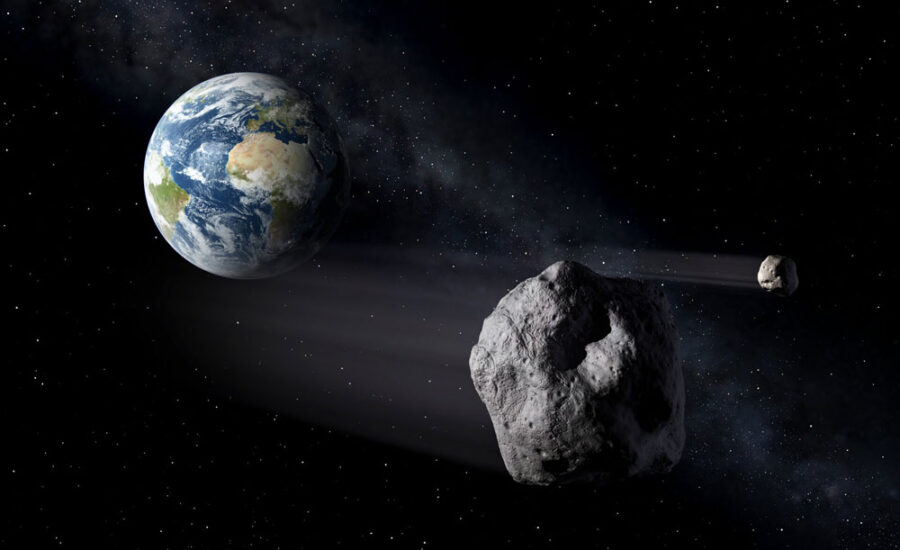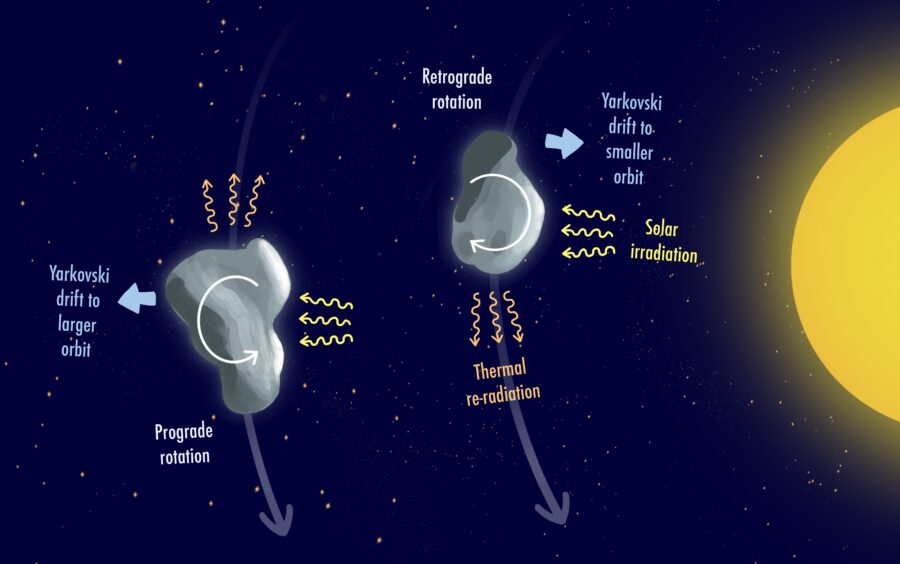Asteroids of different sizes crashing on Earth originated from different parts of the main asteroid belt, researchers say; the finding has implications for how often such collisions happen.

ESA / P. Carril
About 66 million years ago, the Cretaceous–Paleogene extinction killed off all non-avian dinosaurs — a sudden and global event potentially caused by the impact of a massive asteroid. In a new study, researchers have found that such events, while still rare, may have been more frequent than previously thought.
Asteroid impacts are common in the solar system — the crater-scarred surface of the Moon is testimony to that. Earth has also seen its share of asteroid impacts, even more so than the Moon because it’s a larger target. Terrestrial impact basins give an important account of the sizes and compositions of the impactors, as well as the times when those collisions happened.
Scientists are still struggling to understand the intricacies of this perpetual cosmic billiard. "A lot of asteroid science is just about trying to figure out where asteroids come from," says Jessica Noviello (Universities Space Research Association), who was not involved in the study.
The new study to appear in Icarus (preprint available here) sheds new light on the origin and impact rates of the large asteroids that ultimately crashed on Earth. The work suggests impacts of large and carbon-rich asteroids were likely more common in Earth's past than previously thought. The work also hints that asteroids of different sizes come from different parts of the main asteroid belt.
Drifting in the Asteroid Belt
Most asteroids that approach Earth originate in the region between Mars and Jupiter. A journey from there to Earth involves three phases: drift inside the belt, ejection, and crossing orbits with Earth.
Take an asteroid inside the belt. It spins, and it moves around the Sun at a particular orbit. In fact, its life would be pretty uneventful if it weren't for solar radiation illuminating part of its surface. The heated surface emits thermal radiation but in a slightly different direction due to the asteroid's rotation. Because radiation carries momentum, the net effect ever so slightly changes the asteroid's orbit, eventually moving the asteroid either toward or away from the Sun. This drifting force is known as the Yarkovsky effect.

Sarah A. Brands; source: R. Binzel / Nature
Some asteroids’ orbits also become unstable due to planets’ gravitational forces. When an asteroid drifts into such an instability, its orbit changes dramatically, and the asteroid may find itself on its way toward Earth.
The Yarkovsky effect is difficult to calculate in general, and previous simulations have simply placed asteroids directly into unstable orbits to see what would happen. However, David Nesvorný (Southwest Research Institute, Boulder), who led the new study, included the earlier radiation effects that caused the asteroids to drift into unstable regions into his simulations. He focused particularly on large asteroids, for which such effects are much easier to take into account.
The authors calculated motions for the observed population of large asteroids (greater than 5 kilometers across) with known orbits — there are more than 40,000 known asteroids of that size in the main belt. Then, they assigned a reasonable radiation force to each asteroid and calculated how the system evolved.
Where do Earth-impacting Asteroids Come From?
The study predicts that over a billion years, 16 to 32 asteroids greater than 5 kilometers across would hit Earth. Impacts of asteroids spanning more than 10 kilometers are rare and happen about every 250 to 500 million years. Having one such event only 66 million years ago is therefore mildly special.
The simulation also predicts that about half of all large impactors would be dark, not reflecting much light, and that more of these impactors would escape from the outer parts of the belt. A previous simulation that focused on smaller objects showed that most of those impacts came from bright asteroids in the inner belt.
Most of the recorded terrestrial impacts came from small and bright asteroids. Yet, the dinosaur asteroid had a carbon-rich composition, suggesting the asteroid was darker. The new study seems to have solved this discrepancy. Large impactors should be dark half of the time, but they do not occur often. We don't find many simply because a great majority of preserved terrestrial craters formed in only the last 650 million years.
Scientists now need to better understand the differences between the previous and new studies. "Is there really a size dependency in the impact flux or is it more a model-based problem?" wonders Nesvorný.
Noviello is excited about the new findings. “Any time that we pull up a meteorite, it's actually a piece of space that formed very far away,” says Noviello. “It seems that you can actually trace back where that asteroid might have come from. That's really cool.”
 1
1









Comments
Eric Rachut
July 23, 2021 at 4:47 pm
Fascinating article - thanks very much. On a practical note, I am relieved that another such event as the one causing the dinosaur extinction is unlikely in my lifetime, as I am not looking forward to pronouncing another name like Chicxulub.
You must be logged in to post a comment.
You must be logged in to post a comment.